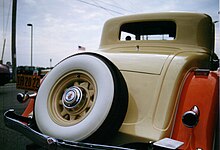
Lincoln Motor Company, or simply Lincoln, is the luxury vehicle division of American automobile manufacturer Ford. Marketed among the top luxury vehicle brands in the United States, Lincoln was positioned closely against its General Motors counterpart Cadillac. The division helped to establish the personal luxury car segment with the 1940 Lincoln Continental.
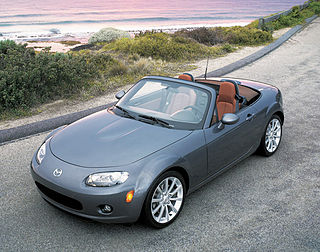
A convertible or cabriolet is a passenger car that can be driven with or without a roof in place. The methods of retracting and storing the roof vary among eras and manufacturers.

The Ford Thunderbird is a personal luxury car manufactured and marketed by Ford from model years 1955-2005, across 11 generations. Introduced as a two-seat convertible, the Thunderbird was offered variously as a four-seat hardtop coupe, four-seat convertible, five-seat convertible and hardtop, four-door pillared hardtop sedan, six-passenger hardtop coupe, and five-passenger pillared coupe, with the final generation designed again as a two-seat convertible.

The Continental Mark II is an ultra-luxury coupé that was sold by the Continental Division of Ford for the 1956 and 1957 model years. The first product line of Continental, the Mark II was developed as the worldwide flagship vehicle of Ford Motor Company. Developed as a successor for the 1939–1948 Lincoln Continental, the Mark II derived its nameplate from European manufacturing practice, denoting a second generation of the model family; Ford would later use this nomenclature for the Mark Series of flagship personal luxury cars.

The Continental Mark III is a personal luxury car marketed by Lincoln from 1969–1971 model years. The namesake successor of the 1956–1957 Continental Mark II, the Mark III again served as the flagship vehicle of Ford Motor Company. Offered as a two-door hardtop coupe, the Mark III was noted for its hidden headlights, rear spare-tire trunk bulge recalling the Mark II and its Rolls-Royce styled grille.

Personal luxury car is a North American car classification describing somewhat sporty, sophisticated mass-market coupés that emphasized comfort over performance. The North American manufacturers most often combined engineering, design, and marketing to develop upscale, distinctive "platform sharing" models that became highly profitable.

The Continental Mark IV is a personal luxury car that was marketed by the Lincoln division of Ford Motor Company from the 1972 to 1976 model years. The third generation of the Mark series, the Mark IV grew in size over its Continental Mark III predecessor. As with the previous generation, the Mark IV saw little direct competition in the American marketplace, competing nearly exclusively against the Cadillac Eldorado.

The Lincoln Town Car is a model line of full-size luxury sedans that was marketed by the Lincoln division of the American automaker Ford Motor Company. Deriving its name from a limousine body style, Lincoln marketed the Town Car from 1981 to 2011, with the nameplate previously serving as the flagship trim of the Lincoln Continental. Produced across three generations for thirty model years, the Town Car was marketed directly against luxury sedans from Cadillac and Chrysler.

Mercury Cougar is a nameplate applied to a diverse series of automobiles sold by the Mercury division of Ford from 1967 until 1997 and from 1999 through 2002 model years. While the nameplate is associated with two-door coupes, at various times during its production, the Cougar was also marketed as a convertible, four-door sedan, station wagon, and a hatchback.
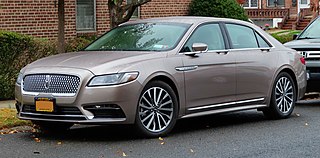
The Lincoln Continental is a series of mid-sized and full-sized luxury cars produced between 1939 and 2020 by Lincoln, a division of the American automaker Ford Motor Company. The model line was introduced following the construction of a personal vehicle for Edsel Ford, who commissioned a coachbuilt 1939 Lincoln-Zephyr convertible, developed as a vacation vehicle to attract potential Lincoln buyers. In what would give the model line its name, the exterior was given European "continental" styling elements, including a rear-mounted spare tire.

The Continental Mark V is a personal luxury coupe marketed in North America by the Lincoln division of Ford Motor Company for model years 1977-1979 — as the fourth generation of the Mark series. At 230 inches (5.8 m) in length, it was the longest two-door coupe Ford has marketed.

The Packard Hawk is a model of automobile. It was the sportiest of the four Packard-badged Studebakers produced in 1958, the final year of Packard production.
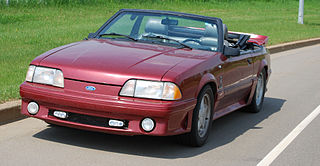
The Ford Fox platform is an automobile platform that was used by Ford Motor Company. Introduced for compact sedans in the 1978 model year, the Fox architecture was utilized for a wide variety of configurations for Ford and Lincoln-Mercury vehicles. In its original form, the platform was used through the 1993 model year; a substantial redesign of the Ford Mustang extended its life into the 21st century, ending production in 2004. Produced across 26 model years, the Fox platform is the second-longest car architecture ever designed by Ford Motor Company.
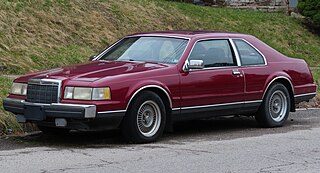
The Continental Mark VII, later changed to Lincoln Mark VII, is a rear wheel drive luxury coupe that was produced by Lincoln. Introduced in August 1983 for the 1984 model year, the Continental Mark VII shared its Ford Fox platform with the Ford Thunderbird, Mercury Cougar, and Lincoln Continental. The Fox platform was originally introduced for the 1978 Ford Fairmont and Mercury Zephyr. The same platform was also utilized as the base for the 1982–1987 Lincoln Continental sedan, the Mark VII's four-door companion. Like its predecessor the Continental Mark VI, the Mark VII was manufactured at the Wixom Assembly Plant in Wixom, Michigan through 1992. It was replaced by the Lincoln Mark VIII in 1993.

The trunk or boot of a car is the vehicle's main storage or cargo compartment, often a hatch at the rear of the vehicle. It can also be called a tailgate.
The Continental Mark series is a series of personal luxury cars that was produced by Ford Motor Company. The nomenclature came into use with the Continental Mark II for 1956, which was a successor to the Lincoln Continental of 1939–1948. Following the discontinuation of the Mark II, Ford continued the use of the Mark series on Continental-branded vehicles from 1958 to 1960.

The Henry J is an American automobile built by the Kaiser-Frazer Corporation and named after its chairman, Henry J. Kaiser. Production of six-cylinder models began in their Willow Run factory in Michigan in July 1950, and four-cylinder production started shortly after Labor Day, 1950. The official public introduction was on September 28, 1950. The car was marketed through 1954.
A spare wheel cover or spare tire cover is an accessory that covers the spare wheel mounted on external part of a car or van. On 4x4 vehicles the spare wheel is normally rear mounted and is often printed with a dealer's name or something more fun. Covers can be hard shells or soft vinyl covers. Spare wheel cover protects spare tires from the dirt and the sun's harmful UV rays in areas with many days of sunshine. Spare wheel covers need to be removed once in a while and cleaned.

A spare tire is an additional tire carried in a motor vehicle as a replacement for one that goes flat, has a blowout, or has another emergency. Spare tire is generally a misnomer, as almost all vehicles actually carry an entire wheel with a tire mounted on it as a spare rather than just a tire, as fitting a tire to a wheel would require a motorist to carry additional, specialized equipment. However, some spare tires are not meant to be driven long distances. Space-savers have a maximum speed of around 50 mph (80 km/h).

The first generation of the Ford Thunderbird is a two-seat convertible produced by Ford for the 1955 to 1957 model year, the first 2-seat Ford since 1938. It was developed in response to the 1953 Motorama display at the New York Auto Show, which showed the Chevrolet Corvette. The Corvette in turn was developed in response to the popularity of European sports cars among Americans.

